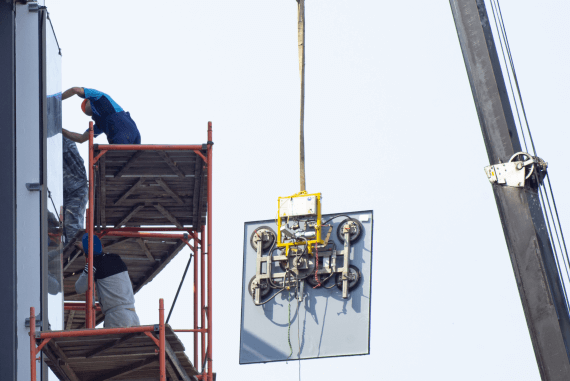- Home ››
- Health and Safety Training ››
- Manual Handling Training ›› Manual Handling and Advanced Materials
Manual Handling and Advanced Materials
Introduction

In certain industries such as construction and demolition, workers will be required to carry heavy and/or awkward loads frequently as part of their daily tasks. In fact, the very definition of construction is taking pieces from one place, moving them into position and assembling them together. It is a job which will require a person to be constantly on their feet, moving items around from one place to another.
Although the potential for manual handling injuries exist in every place of work, workers in these industries will be at particular risk from the dangers. Not only do managers, supervisors and the employees themselves all have a responsibility to reduce the risks, but the materials themselves will also play a significant part in the overall hazard levels.
Construction site managers and workers therefore need to have a thorough knowledge regarding the properties of the materials being used on the site, and the manual handling aids which are available to be used in order to reduce the danger of injuries occuring.
Construction Materials
The advancement of technology and new methods of construction have exciting benefits not only for architecture and internal design, but also have a bearing upon manual handling. This is because new materials have been developed in recent years which still have the required strength as other traditional building materials but are substantially lighter in weight. These include aluminium, carbon fibre and polymer materials.
This lighter weight means that there is a lower risk of builders and construction workers suffering an injury as a result of having to move and manipulate the material into place whilst constructing a building or object. Whereas before a building may have needed a person to move a lot of extremely heavy bricks and steel, construction now might involve a much lighter aluminium frame and composite materials.
But there is still a risk even from lightweight materials, and the importance of safe lifting is still just as paramount. Even though they are lighter, they will still have some weight to them, and this can still be substantial in particularly big pieces. Along with weight, the awkwardness of the load being handled plays a critical role in many manual handling injuries, and many advanced materials can still have these characteristics, such as being difficult to grip properly, or have large dimensions which affect a person's centre of gravity whilst carrying it.
Mechanical Assistance Aids
Not only do advances in the materials benefit the workers who have to handle them, but they will also gain from the development of new equipment and mechanical assistance aids that can be used to move loads into position.
For example, the introduction of machinery which uses air-powered suction cups to hold and move panes of glass has reduced the strains on the bodies of workers in industries such as car manufacturers. Instead of having to be lifted and moved into position, often by more than one person at a time due to the weight and size, one person can guide the glass panel into position using a hydraulic machine and the air suction cups.
Before, there were all sorts of dangers of having to move the glass entirely by hand. These included:
Manual Handling Injuries: Having to lift, push, pull etc a large single pane of glass could put significant strain on a person's body, even if lifting as part of a team. This could be even more serious if the load were to shift somehow so that the weight of it was no longer distributed evenly amongst all of those moving it. If this were to happen, one person could end up taking the bulk of the weight, which could over-exert their body and result in a serious injury.
Sharp Edges: The edges and corners of glass panels can be sharp, and are especially so if the glass becomes broken somehow during the moving process. This can lead to nasty cuts to the hands for those handling the pane.
Crush Injuries: Of course, the fancy new air-powered suction cup machine could fail and cause the glass panel to fall, but it is unlikely if equipment is maintained well and those using it have been suitably trained in its correct operation. Far more likely is the potential for the glass to be dropped when simply being carried by one or more people who are having to take its full weight at all times.
If this large, heavy object were to fall to the ground, it could cause a serious crush injury, with feet and toes being especially at risk. Although being dropped on toes is bad enough, the consequences could be far worse if the panel were to fall from a height and land on someone below if, say, a window was being moved into position and installed entirely by hand and fell to the ground below. Depending on the weight of the glass and the height it fell from, the results could ultimately be fatal.
Conclusion
So although technology is making materials lighter and improving the availability of assistance equipment, manual handling risks are still highly prevalent and workers need to receive proper training in order to safeguard their health and safety and reduce the chances of suffering an injury.
With new designs, materials and assistance aids being introduced to the construction site all of the time, it is imperative that workers and managers alike are fully up to speed with the latest developments. Health and safety knowledge needs to be kept constantly updated in all industries, and construction is no exception. A failure to take advantage of new mechanical assistance tools, or not learning how to operate and maintain them correctly, will put workers (and perhaps nearby members of the public) at unnecessary risk than they would otherwise need to be.


